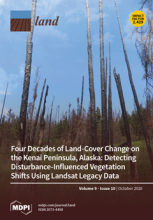Land Library
Bienvenue dans la bibliothèque du Land Portal. Explorez notre vaste collection de ressources en libre accès (plus de 74 000), comprenant des rapports, des articles scientifiques, des articles de recherche, des publications évaluées par des pairs, des documents juridiques, des vidéos et bien plus encore.
/ library resources
Showing items 1 through 9 of 62.The stabling of livestock farming implies changes in both local ecosystems (regeneration of forest stands via reduced grazing) and those located thousands of kilometers away (deforestation to produce grain for feeding livestock). Despite their importance, these externalities are poorly known.
The burning and the deforestation of the Brazilian Amazon forest, which has been recently highlighted by the international press and occurs mostly on public or undesignated land, calls for an in-depth examination.
Over the past 40 years, roads have been the main driver behind the State of Acre’s occupation and development. However, the expansion of roads, has often been associated with the advance of deforestation, habitat fragmentation, and social conflicts.
The present study focuses on identifying and describing the possible proximate and underlying causes of deforestation and its factors using the combination of two techniques: (1) specialized consultation and (2) spatial logistic regression modeling.
The 2019 fire crisis in Amazonia dominated global news and triggered fundamental questions about the possible causes behind it. Here we performed an in-depth investigation of the drivers of active fire anomalies in the Brazilian Amazon biome.
With 15–20% of Indonesian oil palms located, without a legal basis and permits, within the forest zone (‘Kawasan hutan’), international concerns regarding deforestation affect the totality of Indonesian palm oil export.
Mountainous regions are more sensitive to climatic condition changes and are susceptible to recent increases in temperature. Due to urbanization and land use/land cover (LULC) issues, Cameron Highlands has been impacted by rising land surface temperature (LST) variation.
Papua New Guinea is a country in Oceania that hosts unique rain forests and forest ecosystems which are crucial for sequestering atmospheric carbon, conserving biodiversity, supporting the livelihood of indigenous people, and underpinning the timber market of the country.
We investigated the spatial relations of ecological and social processes to point at how state policies, population density, migration dynamics, topography, and socio-economic values of ‘forest coffee’ together shaped forest cover changes since 1958 in southwest Ethiopia.




